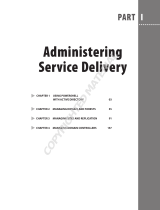
Adding and Configuring Servers and Hosts....................................................................................... 24
Adding and Organizing Servers and Server Folders.....................................................................25
Configure Servers..........................................................................................................................26
4 Backing Up and Restoring Data.......................................................................30
Using the Replay Manager Explorer................................................................................................... 30
Display Storage Components and Restore Points.......................................................................30
View Component Details..............................................................................................................30
View Restore Point Details............................................................................................................ 31
View a Restore Point Report......................................................................................................... 33
Understanding Backup Types.............................................................................................................33
Windows Backup Types................................................................................................................ 33
VMware Backup Types..................................................................................................................34
Guidelines for Creating Backup Sets............................................................................................34
Guidelines for Backup Sets in VMware Datacenters....................................................................34
Guidelines for Backup Jobs.......................................................................................................... 35
Backing Up a Boot Volume (LUN 0)............................................................................................. 35
Guidelines for Scheduling and Expiring Replays..........................................................................35
Extension-Specific Best Practices.................................................................................................35
Summary of Backup Set Actions........................................................................................................ 36
Backup Set Actions........................................................................................................................36
Summary of Backup Set Options........................................................................................................37
Summary of Backup Set Options..................................................................................................37
Creating and Running Backups.......................................................................................................... 38
Create and Run a Backup Now.....................................................................................................38
Create and Schedule a Backup.....................................................................................................39
Managing Existing Backup Sets..........................................................................................................40
Run an Existing Backup Set Now..................................................................................................40
Modify Settings for an Existing Backup Set .................................................................................40
Modify Schedules for an Existing Backup Set..............................................................................40
Add or Remove Components from an Existing Backup Set (Microsoft Extensions Only)..........41
Delete a Backup Set.......................................................................................................................41
Prepare an Existing Backup Set for a Script..................................................................................41
Managing Restore Points and Restoring Data................................................................................... 42
Summary of Restore Point Actions...............................................................................................42
Transport-to-Server Scenarios.....................................................................................................44
Restoring Data.....................................................................................................................................45
Display Restore Points for a Component.....................................................................................45
Restore Data to its Original Location........................................................................................... 45
Restore SQL Server Components without Recovering the Database........................................ 46
Rename and Restore SQL Server Components Stored on a Volume.........................................46
Rename and Restore SQL Server Components Stored on an SMB File Share........................... 47
4






















